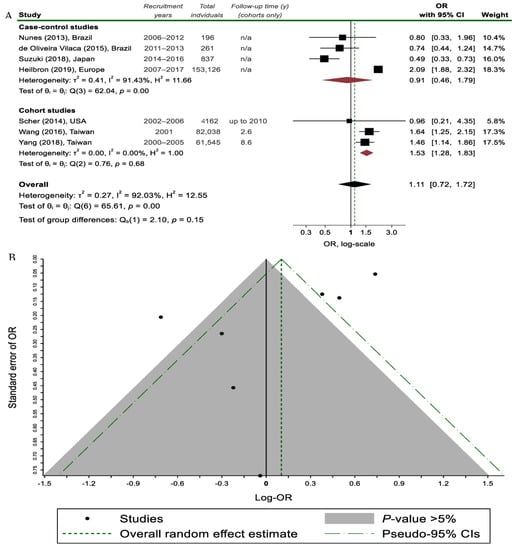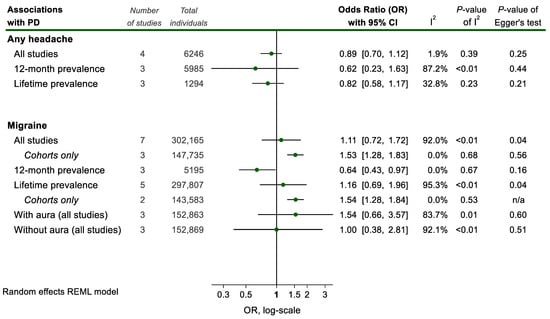You're using an outdated browser. Please upgrade to a modern browser for the best experience.
Please note this is a comparison between Version 1 by Anastasia Bougea and Version 2 by Dean Liu.
The relationship between migraine and tension-type headache (TTH) with Parkinson’s disease (PD) is controversial, while a common pathophysiological link remains obscure. The aim of rethis sysearcherstematic review is to investigate the association between PD, migraine and TTH.
- Parkinson’s disease (PD)
- migraine
- tension-type headache (TTH)
- non-motor symptoms (NMS)
1. Introduction
Although Parkinson’s disease (PD) is classified as a motor neurodegenerative disorder, non-motor symptoms (NMSs)are common, such as sleep disorders, depression, cognitive deficits and pain [1]. Among PD patients, different pain phenotypes and/or classification shave been described: PD-related (including fluctuation-related, dyskinesia -related and central pain) vs. non-PD-related pain; primary vs. secondary (musculoskeletal system) pain; nociceptive vs. neuropathic; chronic vs. acute; and pain according to different body parts [2][3][4][5][2,3,4,5]. However, the exact pain etiology in PD remains unclear; as a consequence, therapeutic options are often ineffective [6].
Primary headaches (i.e., migraine and tension-type headache (TTH)) are commonpain disorders with several comorbidities, such as cardiovascular disease, stroke, depression and various dementias, and are accompanied by a substantial socioeconomic impact [7][8][7,8].Over the previous two decades, several studies have suggested a link between primary headaches and PD [9][10][11][9,10,11], while others have produced conflicting results [12][13][12,13]. Barbanti et al. identified a lifetime migraine prevalence of 27.8% and a current migraine prevalence of 13.1% in a population of PD patients [14]. Moreover, a cohort study showed that subjects with a midlife history of headache and, particularly, those with migraine with aura had an increased likelihood of PD [9].By contrast, Nunes et al. [15] demonstrated that PD patients had a lower lifetime prevalence of headache than controls. Previous studies have focused on the relationship between migraine and PD, and a prior validation study reported that 80% of individuals with non-migrainous headache might have TTH [16]. However, the supposed overlapping PD and headache pathophysiological mechanisms remain obscure [17]. Despite the high prevalence of migraine across various PD populations [14][15][14,15], headache remains an underestimated and undertreated NMS contributing to a poor quality of life among PD patients [14].
A clarification of the examined relationship will provide valuable knowledge to neurologists in determining the modifiable causes of poor outcomes.
2. Headache Prevalence in PD Patients
The overall pooled prevalence of any headache (including migraine and TTH) among PD patients was 49.1% (5 studies; 760 PD patients; 40.9%; 49.1% with 95% CI 24.8–73.6; and I2 = 97.3%, Figure 12). The 12-month prevalence of migraine among PD patients was calculated at 13.1% (3 studies; 771 PD patients; 11.2%; 13.1% with 95% CI 3.8–26.2; and I2 = 94.1%), while the lifetime prevalence was expectedly higher at 15.7% (5 studies; 1144 PD patients; 14.5%; 15.7% with 95% CI 7.9–25.2; and I2 = 92.3%, Figure 12). Only very few PD patients had received a diagnosis of migraine with aura (3 studies; 719 PD patients; 2.6%; 0.2% with 95% CI 0.0–8.6; and I2 = 93.5%).
Figure 2. Meta-analyses of proportions examining headache prevalence (%) among Parkinson’s disease (PD) patients. Results of each individual random effects meta-analysis are depicted as black data markers; 95% confidence intervals (CI) are indicated by the black error bars. I2 reflects each meta-analysis heterogeneity.
3. Association between PD and Migraine
Overall, regarding the relationship between PD and migraine, no statistically significant association was found (7 studies; 302,165 individuals; ORpooled = 1.11, 95% CI 0.72–1.72; and I2 = 92.0%; Figure 23).
Figure 23. (A) Random effects meta-analysis on the association between migraine headaches and Parkinson’s disease (PD) status stratified by study design; (B) Funnel plot, where each study is depicted as a dot. The light grey shaded area contains studies with non-significant results (p > 0.05) [7][9][15][18][19][20][21][7,9,15,22,27,31,32].

Figure 34. Meta-analyses of associations between headache and Parkinson Disease (PD) status. Results of each individual random effects meta-analysis (odds ratios (OR)) are depicted as green data markers; 95% confidence intervals (CI) are indicated by the black error bars. I2 reflects each meta-analysis heterogeneity.
